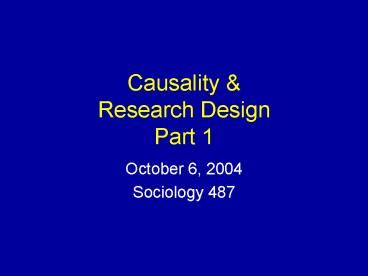Causality PowerPoint PPT Presentation
1 / 16
Title: Causality
1
Causality Research DesignPart 1
- October 6, 2004
- Sociology 487
2
Lecture Topics
- Nomothetic and Idiographic Causal Explanations
- Types of Causes
- Criteria for Determining Causality
3
Idiographic Causal Explanations
- Individual sequence of events that result in a
particular outcome for a particular individual - Emphasis on context
- Holistic
- Deterministic
4
Nomothetic Causal Explanations
- Change in independent variable leads to change in
dependent variable, ceteris paribus - Ceteris Paribus means all else equal
- Probabilistic
- The counterfactual
- Situation as it would have been in absence of
variation in independent variable
5
Types of Causes
- Necessary cause
- Condition that must be present for outcome to
result - Sufficient cause
- Condition that, if present, ensures outcome
6
Major Criteria for Determining Causality
- Temporal priority of the independent variable
- Empirical association
- Nonspurious relationship
7
Temporal Priority
The change in X must occur before the change in Y.
?X
?Y
t1 t2
8
Empirical Association
The independent variable and the dependent
variable must vary together.
A change in X is associated with a change in Y.
?X
?Y
9
Spurious Relationship
- Relationship that is explained away by variables
other than those included in the research
hypothesis
10
Reducing Risks of Spurious Relationship
- Random assignment
- Statistical control
11
Two Additional Criteria for Determining
Causality
- Identifying a causal mechanism
- Specifying the context in which the effect occurs
12
Identifying Causal Mechanisms
- Identifying process through which X affects Y
- Intervening variables
13
Intervening and Extraneous Variables
- Intervening Variables
- Helps explain the effect of X on Y
- Extraneous Variables
- Explains away the spurious relationship between X
and Y
14
Determining Context in which Effect Occurs
- When does effect occur?
- For whom does effect occur?
- Under what conditions does effect occur?
15
Causality and Research Design
- Design of your study will help you assess
causality - Cross-sectional versus longitudinal designs
- Use of different units of analysis
16
Key Points
- Both idiographic and nomothetic explanations are
concerned with causation - Three basic criteria for establishing nomothetic
causation - X must precede Y
- X must be associated with Y
- Effect of X on Y is not due to effect of Z on
both X and Y - Two additional criteria used to assess causality
- Specification of causal mechanism through which X
affects Y - Specification of the context in which X affects Y

